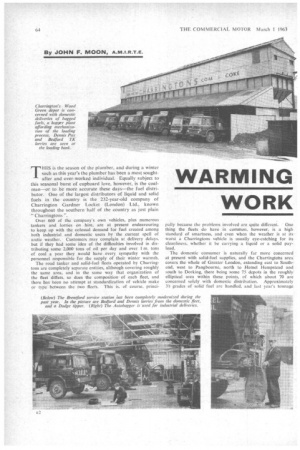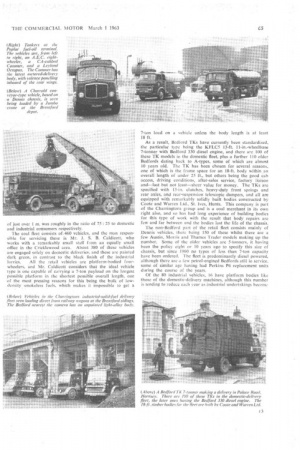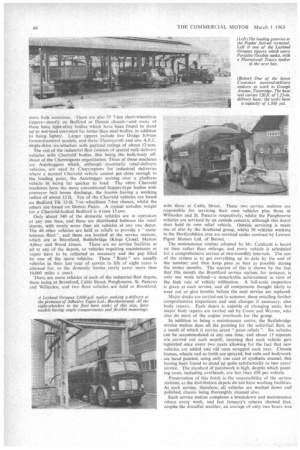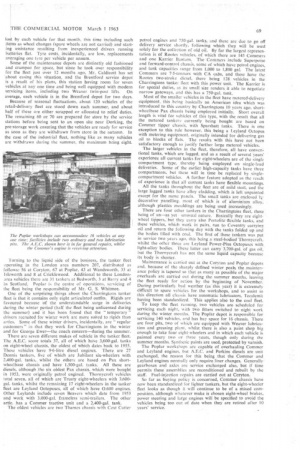WARMING WORK
Page 66

Page 67

Page 68

Page 71

If you've noticed an error in this article please click here to report it so we can fix it.
By JOHN F. MOON, A.M.I.R.T.E.
THIS is the season of the plumber, and during a winter such as this year's the plumber has been a most soughtafter and over-worked individual. Equally subject to this seasonal burst of cupboard love, however, is the coalman—or to be more accurate these days—the fuel distributor. One of the largest distributors of liquid and solid fuels in the country is the 232-year-old company of Charrington Gardner Locket (London) Ltd., known throughout the southern half of the country as just plain " Cha rringtons ".
Over 660 of the company's own vehicles, plus numerous tankers and lorries on hire, are at present endeavouring to keep up with the colossal demand for fuel created among both industrial and domestic users by the current spell of arctic weather. Customers may complain at delivery delays. but if they had some idea of the difficulties involved in distributing some 2,000 tons of oil per day and over 1 m. tons of coal a year they would have every sympathy with the personnel responsible for the supply of their winter warmth.
The road tanker and solid-fuel fleets operated by Charringtons are completely separate entities, although covering roughly the same area, and in the same way that organization of the fleet differs, so does the composition of each fleet, and there has been no attempt at standardization of vehicle make or type between the two fleets. This is, of course, princi pally because the problems involved are quite different. One thing the fleets do have in common, however, is a high standard of smartness, and even when the weather is at its worst a Charringtons vehicle is usually eye-catching for its cleanliness, whether it be carrying a liquid or a solid payload.
The domestic consumer is naturally far more Concerned at present with solid-fuel supplies, and the Charringtohs area Covers the whole of Greater London, extending east to Southend, west to Pangbourne, north to Hemel Hempstead and south to Dorking, there being some 75 depots in the roughly elliptical area within these points, of which about 70 are concerned solely with domestic distribution. Approximately 3:) grades of solid fuel arc handled, and last year's tonnage
of just over I m. was roughly in the ratio of 75 25 to domestic and industrial consumers respectively.
The coal fleet consists of. 460 vehicles, and the man responsible for servicing these is Mr. J. S. B. Caldicott, who works with a remarkably small staff from an eqtially small office in the Cricklewood area. About 380 of these vehicles are engaged solely on domestic deliveries, and these are painted dark green, in contrast to the black finish of the industrial
lorries. All the retail vehicles are platform-bodied fourwheelers, and Mr. Caldicott considers that the ideal vehicle type is one capable of carrying a 7-ton payload on ihe longest Possible platform in the shortest possible overall length, one of the most pressing reasons for this being the bulk of lowdensity smokeless fuels, which makes it impossible to get a
7-ton load on a vehicle unless the body length is at least 18 ft.
As a result, Bedford TKs have currently been standardized, the particular type being the KFLC5 13-ft. 1I-in.-wheelbase 7-tonner with Bedford 330 diesel engine, and there are 100 of these TK models in the domestic fleet plus a further 110 older Bedfords dating back to A-types, some of which are almost 10 years old. The TK has been chosen for several reasons, one of which is the frame space for an 18-ft. body within an overall length of under 25 ft., but others being the good cab access, driving conditions, after-sales service; factory liaison and—last but not least—sheer value for Money. The TKs are specified with 13-in, clutches, heavy-duty front springs and rear axles, and rear-suspension telescopic dampers, and all are equipped with remarkably solidly built bodies constructed by Coote and Warren Ltd., St. Ives, Hunts. This company is part of the Charringtons group and is a coal merchant in its own right also, and so has had long experience of building bodies for this type of work with the result that body repairs are few and far between and the bodies last the life of the chassis.
The non-Bedford part of the retail fleet consists mainly of Dennis vehicles, there being 150 of these whilst there are a few Austin. Morris and Thames Trader models making up the number. Some of the older vehicles are 5-tonners, it having been the policy eight or 10 years ago to specify this size of chassis, but since 1960 no types of less than 7-ton capacity have been ordered. The fleet is predominantly diesel powered, although there are a few petrol-engined Bedfords still in service. some of similar age having had Perkins P6 replacement units during the course of the years.
Of the 80 industrial vehicles, 16 have platform bodies like those of the domestic-delivery machines, although this number is tending to reduce each year as industrial undertakings become more bulk Conscious. There are also 25 7-ton short-wheelbase tippers—mostly on Bedford or Dennis chassis—and many of these have light-alloy bodies which have been found to stand up to wet-load corrosion far better than steel bodies, in addition to being lighter. Larger tippers include five Dodge 8/9-ton forward-control models, and three Thornyeroft and one A.E.C. single-drive six-wheelers with payload ratings of about 12 tons.
The reSt of the industrial fleet consists of special bulk-delivery vehicles with Charrold bodies, this being the bulk-body offshoot of the Charringtons organiZation. Three of these.machines are Autobaggers which, although essentially retail-delivery vehicles, are used by Charringtons for industrial deliveries where a normal Charrold vehicle cannot get close enough to the loading point, the Autobagger scoring over a platform vehicle in being far quicker to load. The other Charrold machines have the more conventional hopper-type bodies with conveyor belt boom discharge, the booms having a working radius of about 12 ft. Ten of the Charrold vehicles are based on Bedford TK 12-ft. 7-in.-wheelbase 7-ton chassis, whilst the others are based on Dennis Paxes. A typical unladen weight for a Charrold-bodied Bedford is 4 tons 15 cwt.
Only about 340 of the domestic vehicles are in operation at any one time, and these are distributed between the retail depots, with rarely more than six vehicles at any one depot. The 40 other vehicles are held as reliefs to provide a "maintenance float ", and these are located at the service stations, which are at Brentford, Battlebridge (Kings Cross), Merton Abbey and Wood Green. There are no service facilities at all at any of the depots, so vehicles requiring maintenance or repair have to be collected as necessary and the gap filled by one of the spare vehicles. These " floats " are usually vehicles in their last year of service (a life of eight years is allowed for, as the domestic lorries rarely cover more than 10,000 miles a year).
There are More vehicles at each of the industrial-fleet depots, these being at Brentford, Cable Street, Pangbourne, St. Pancras and Willesden, and two float vehicles are held at Brentford, with three at Cable Street. These two service stations are responsible for servicing their own vehicles plus those at Willesden and St. Pancras respectively, whilst the Pangbourne vehicles are serviced by an outside concern, although this depot does hold its own relief vehicle. Outside servicing is made use of also by the Southend group, whilst 50 vehicles working in the Hertfordshire area are serviced under contract by Lawson Pigott Motors Ltd. of Barnet.
The maintenance routine adopted by Mr. Caldicott is based on time rather than mileage, and every vehicle is scheduled for a comprehensive service at two-monthly intervals. The aim of the system is to get everything up to date by the end of the summer and then keep pace as best as possible during the winter months. The success of this is shown by the fact that this month the Brentford service station, for instance, is only one week behind—a remarkable achievement in view of the high rate of vehicle utilization. A full-scale inspection is given at each service, and all components thought likely to wear out or give trouble before the next service are replaced.
Major docks are carried out in summer, these entailing further comprehensive inspections and unit changes if necessary, also body repairs. Each depot is capable of changing units, but major body repairs are carried out by Coote and Warren, who also do most of the engine overhauls for the group.
In addition to being a maintenance centre, the Battlebridge service station does all the painting for the solid-fuel fleet, as a result of which it carries seven "paint reliefs ". Six vehicles can be accommodated at any one time, and about 15 repaints are carried out each month, meaning that each vehicle gets repainted once every two years allowing for the fact that new vehicles are added and old ones scrapped each year. Chassis frames, wheels and so forth are sprayed, but cabs and bodywork . are hand painted, using only one coat of synthetic enamel, this having been found to stand up quite satisfactorily to two years' service. The standard of paintwork is high, despite which painting costs, including overheads, are less than £50 per vehicle.
Preservation of this finish is the responsibility of the service stations, as the distribution depots do not have washing facilities. At each service, therefore, all vehicles are washed down and polished, chassis being thoroughly cleaned also.
Each service station compleZes a breakdown and maintenance return every week, and last January's returns showed that, despite the dreadful weather, an average of only two hours was 1ot by each vehicle for that month, this time including such iteT1s as wheel changes (spare wheels are not carried) and start in resulting from inexperienced drivers running bateries flat. Tyre costs, incidentally, are low, replacements av raging one tyre per vehicle per annum. Some of the maintenance depots are distinctly old fashioned and cramped for space, but since he took over responsibility for the fleet just over 12 months ago, Mr. Caldicott has set about easing this situation, and the Brentford service depot is a result of his plans, this station having room for seven vehicles at any one time and being well equipped with modern servicing items, including two Weaver twin-post lifts. On average, each vehicle is in the Brentford depot for two days.
Because of seasonal fluctuations. about 120 vehicles of the retail-delivery fleet are stood down each summer, and about half of these are either scrapped or allocated to relief duties. The remaining 60 or 70 are prepared for store by the service stations before being sent to an onen site near Dorking, the pre-storage work ensuring that the vehicles are ready for service as Soon as they are withdrawn from store in the autumn. In the case of the industrial fleet, nothing like as many vehicles are withdrawn during the summer. the maximum being eight.
Turning to the liquid side of the business, the tanker fleet operating in the London area numbers 207, distributed as follows:56 at Coryton, 67 at Poplar, 43 at Wandsworth, 33 at Isleworth and 8 at Cricklewood. Additional to these Londonarea vehicles there are 31 tankers at Bedworth, 3 at Barry and 4 in Scotland. Poplar is the centre of operations. servicing of the fleet being the responsibility of Mr. G. S. Whitmee. One of the surprising things about the Charringtons tanker fleet is that it contains only eight articulated outfits, Rigids are favoured because of the understandable surge in deliveries during the winter period (half the fleet being unlicensed during the summer) and it has been found that the temporary drivers recruited for winter work are more suited to rigids than artics. Some of these winter drivers, incidentally, are " regular customers" in that they work for Charringtons in the winter and for George Ewer—the coach concern—during the summer.
There are seven different makes of vehicle in the tanker fleet. The A.E.C. score totals 37, all of which have 3,600-gal. tanks on eight-wheel chassis, the oldest of which dates back to 1955. These vehicles have 9.6-litre diesel engines. There are 27 Dennis tankers, five of which are Jubilant six-wheelers with 2,400-gal. tanks, whilst the others are based on Pax shortwheelbase chassis and have 1,500-gal. tanks. All these are diesels. although the six oldest Pax chassis, which were bought in 1953, were originally petrol engined. Thornycroft vehicles total seven, all of which are Trusty eight-wheelers with 3,600gal. tanks, whilst the remaining 17 eight-wheelers in the tanker fleet are Leyland Octopuses, all of which have 0.600 engines. Other Leylands include seven Beavers which date from 1953 and work with 3,000-gal. frameless semi-trailers. The other artic. has a Commer tractive unit and a 2,400-gal. tank.
The oldest vehicles are two Thames chassis with Cost Cutter petrol engines and 750-gal. tanks, and these are due to go off delivery service shortly, following which they will be used solely for the collection of old oil. By far the' largest represen tation is of Rootes vehicles, of which there are 145 Cornmers and one Karrier Bantam, ThcCornmers'Include Superpoise
and forward-control chassis, some of which have petrol engines,
and tank capacities range from 1,000 to 1,800 gal. The latest Commers are 7-5-tonners with CA cabs, and these have the Rootes two-stroke diesel, there being 128 .vehicles in the Charringtons tanker fleet with this power unit. The Karrier is for special duties, as its small siie renders it able 'to negotiate narrow gateways, and this has a 750-gal. tank.
Most of the smaller vehicles in the fleet have metered-delivery equipment, this being basically an American idea which was introduced to this country by Charringtons 10 years ago, shortwheelbase Pax chassis being employed initially. Short overall length is vital for vehicles of this type, with the result that all the metered tankers' currently being bought are based on Commer tipper chassis, with Sparshatt tanks. There is one exception to this rule however, this being a Leyland Octopus with metering equipment, originally intended for delikering gas oil to blocks of flats. The results with this have not been satisfactory enough to justify further large metered vehicles.
The larger vehicles in the fleet, therefore, all have conventional tanks, which are lagged; and as a result of several years' experience all current tanks for eight-wheelers are of the single compartment type, thereby being employed on single-load deliveries. Some of the earlier high-capacity tanks have three compartments,' but these will in time be replaced by singlecompartment vehicles. A further feature adopted as the result of experience is that all current tanks have flexible mountings.
All the tanks throughout the fleet are of mild steel, and the large lagged tanks have alloy cladding, which is left unpainted except for the name panels. The small tahks are enclosed decorative panelling, most of which is of alinninium alloy, although plastics mouldings are being used increasingly, There are four other tankers in the Charringtcins fleet, these being of an—as yet--unusual nature. Basically they are eightwheel tiPpers,.but they carry also Portolite -flexible tanks, and these vehicles, which work in' pairs, run to Coventry carryinu oil and return the following day 'with the tanks folded up and the bodies filled with coal. The first of these tankers was put in service two years ago, this being a steel-boclied Thornycroft, whilst the other three are Leyland Power-Plus Octopuses with light-alloy bodies. These latter Can Carry 3,700-gal. 'of gas oil, but the Thornycroft has not the same liquid capacity because its body is shorter, Maintenance is carried out at the Coryton and Poplar depots and, because of the sharply defined winter peaks the mainten ance policy is tapered so that as many as possible of the major overhauls are .carried out during the summer months. leaving the fleet ready for action by the beginning of November.
During particularly bad weather (as'this year) it is extremely
difficult to spare kehicles for the workshops, and to assist in this direction all chassis have automatic lubricators, Tecalemit
having been standardized. This applies also to the coal fleet.
To keep the fleet running, two vehicles are scheduled for servicing each night, with two fitters switched to night work during the winter months. The Poplar depot is responsible for servicing 140 vehicles. and has bay space for 16 chassis. There are four pits, two of which are equipped with Weaver lubrica tion and greasing plant, whilst there is also a paint shop big enough to take four eight-wheelers and in which each vehicle is painted every two or three years, though only during the summer.months. Synthetic paints are used, protected by varnish.
The Poplar workshops arc capable of overhauling Commer and Leyland engines, but A.E.C. and Perkins diesels are unit
exchanged, the reason for this being that the Commer and Leyland engines normally only require liner changes. Generally gearboxes and axles are service exchanged also, but if time permits these' assemblies are reconditioned and rebuilt by the staff. Fuel-injection repairs are carried out at Coryton.
So far as buying policy is concerned, Commer chassis have now been standardized for lighter tankers, but the eight-wheeler fleet looks as though it will continue to be of a mixed composition, although whatever make is chosen eight-wheel brakes, power steering and large engines will be specified to avoid the vehicles being too out of date when they are retired after 10 years' service.
















































































































































